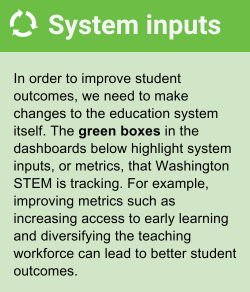STEM by the Numbers Dashboard
 STEM by the Numbers dashboards track key indicators for early learning, K-12 and career pathways.
STEM by the Numbers dashboards track key indicators for early learning, K-12 and career pathways.
The dashboards in Kindergarten Math Readiness and Postsecondary Progress provide statewide and regional data to let us know if Washington’s education systems are supporting more students — especially students of color, rural students, girls and young women, and students experiencing poverty — to be on track to attain the postsecondary credentials that lead to high-demand careers paying a family-sustaining wage.
Jump to a dashboard:
Kindergarten Math-ready | Postsecondary Progress
Kindergarten Math-ready: Across Washington, access to high-quality early learning is linked to development and achievement when young students arrive in K-12 schools. However, in Washington state, only 68% of children in kindergarten are math-ready. At the same time, two-thirds of children with all parents in the workforce do not have access to early learning programs. Families with low incomes and with an infant and/or toddler face the largest gaps in access to affordable and quality child care. The chart below shows the percentage (%) of math-ready kindergartners by gender, race/ethnicity and whether they are English language learners, or in low-income households. For historical comparison (2015-2022), hover mouse over a bar.
The Postsecondary Progress dashboard includes five sub-sections that track key indicators in postsecondary education for the 2021 five-year cohort of Washington-originating high school graduates.
- Credential Attainment: Credential Attainment projects what increase in credential attainment will be needed to ensure that students in the region are equitably prepared to acquire high-demand jobs that pay household-sustaining wages.
- Enrollment Representation rates: Top graph provides snapshots of regional teacher diversity compared to student demographics; bottom graph displays demographics and equity of representation of the students enrolled in postsecondary programs.
- Enrollment and Completion rates: Two pie charts show enrollment and projected completion rates, at the regional and state levels. A second graphic illustrates the data that shows how members of the 2021 cohort detour off the path of postsecondary credentials.
- Enrollment Demographics: This chart breaks down postsecondary enrollment within one year of graduation by gender, ethnicity and income level.
- Enrollment Tables: This table provides enrollment details for graduates, by high school in each region.
To download these graphs, click the download icon at right.